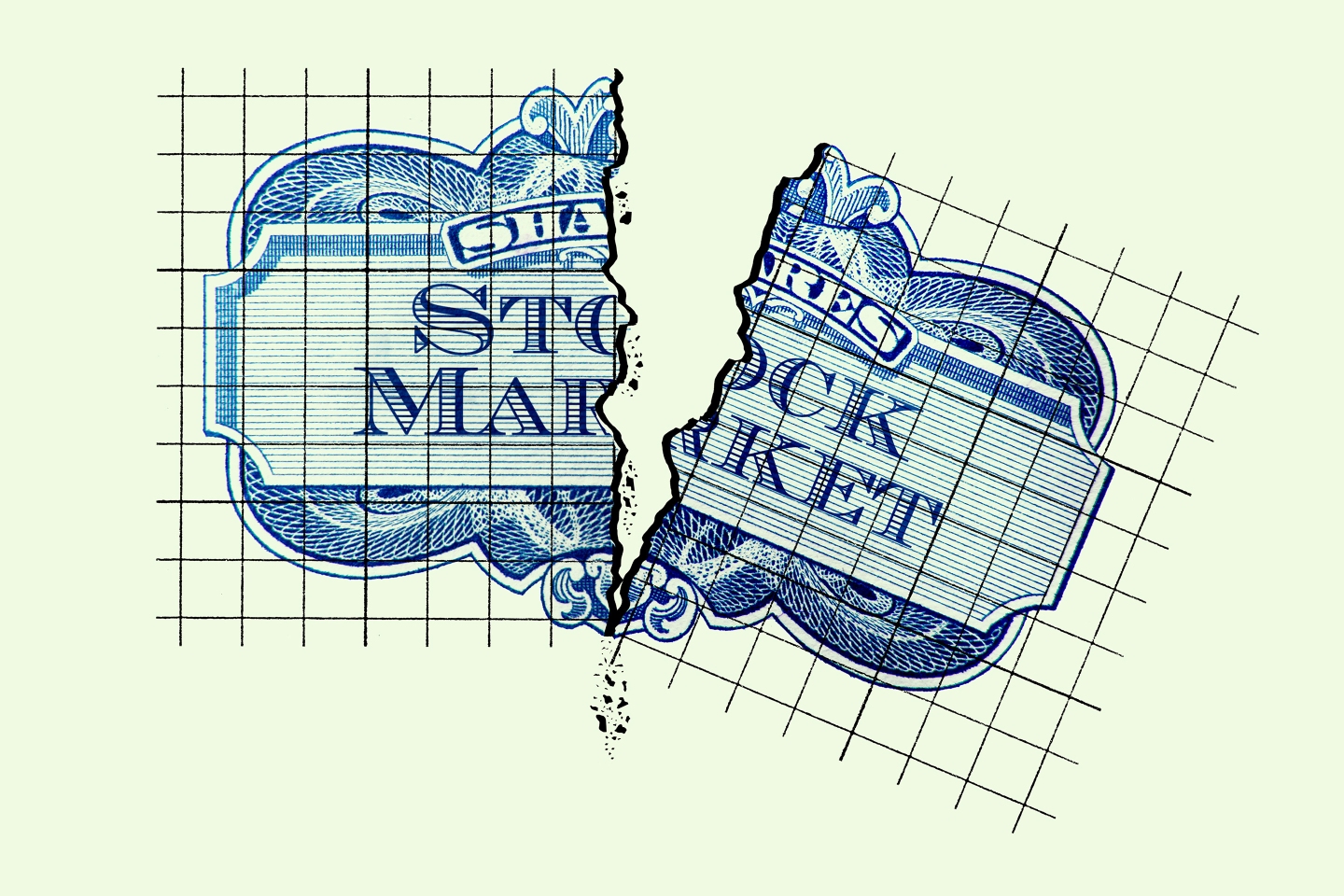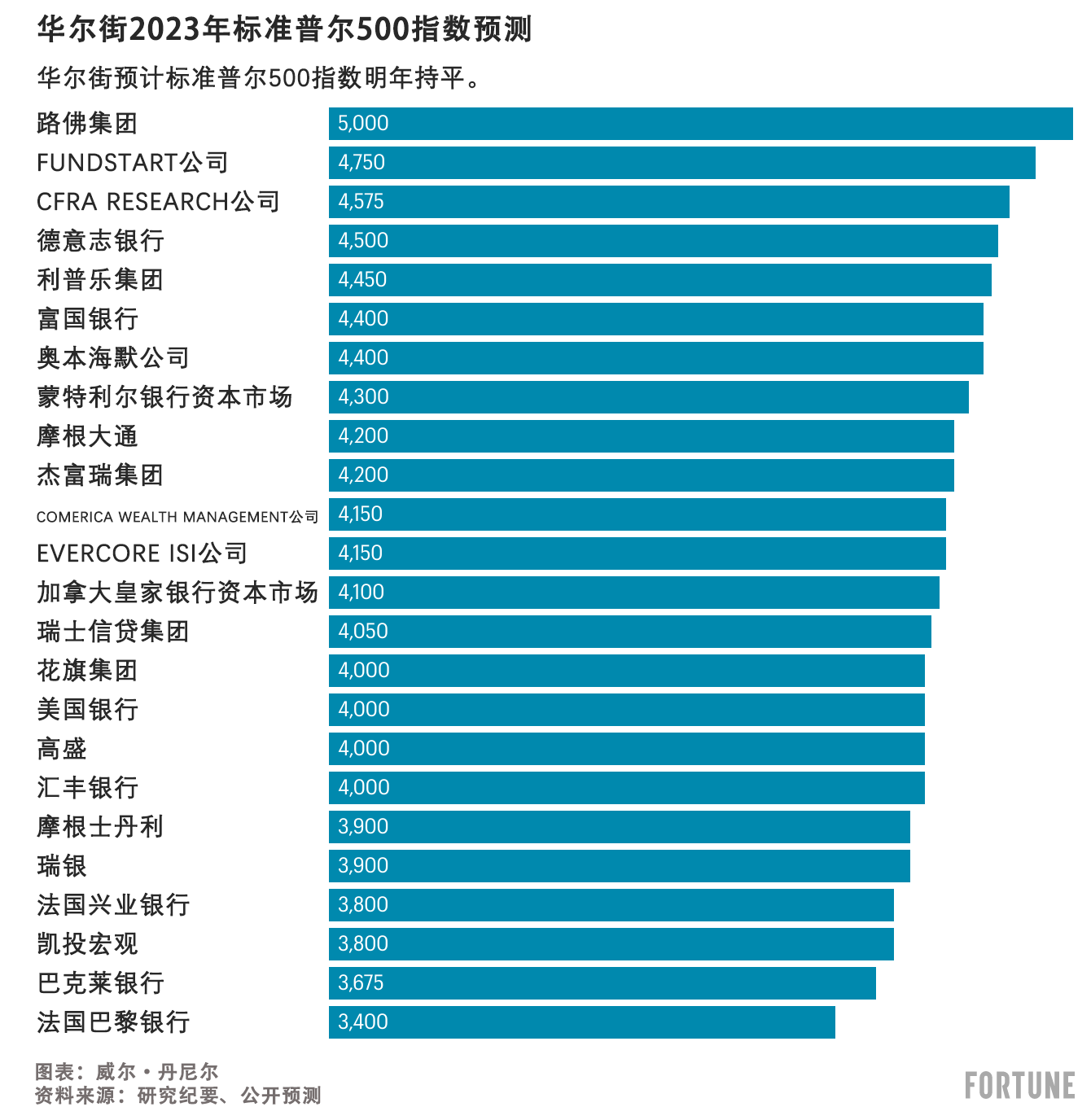
投资者正在庆祝2022年的结束,此前的通胀飙升和美联储大举加息,使2022年对股市来说是残酷一年。
2022年以来,标准普尔500指数(S&P 500)下跌了20%,而与此同时,债券经历了历史上最糟糕的一年,投资者无处可藏。2008年金融危机结束后的十多年里,投资者获得了强劲回报,所以目前大多数投资者都难以习惯这样的艰难局势。
根据纽约大学的数据,2009年至2021年期间,标准普尔500指数的平均年回报率高达16.4%。但别指望2023年能够有这样的增长。
投资银行认为标准普尔500指数2023年的平均目标价格约为4,000点,这意味着股票将仅上涨4%。《财富》杂志收集了更多的华尔街经济学家和分析师的预测,这一数字将在2023年升至4,150点,即增长8%。不过,这与大多数投资者所习惯的情况完全不同。

虽然投资银行认为标准普尔500指数在2023年收盘时将略高于目前水平,但华尔街的普遍共识是,实现这一目标的道路是崎岖的。
“我们给投资者的建议是要谨慎行事。美联储正在试图推动经济软着陆,在我们看来,这种软着陆很有可能失败,并在2023年引发经济衰退。”Main Street Research的首席投资官詹姆斯·德默特在接受《财富》杂志采访时表示。“股指在当前水平上很脆弱。”
2023年要谨防艰难开局
在整个华尔街,投资策略师警告称,随着美联储进入对抗通胀的最后阶段,股市将在2023年迎来艰难开局。以消费者物价指数(CPI)衡量的同比通胀率已经从2022年6月9.1%的峰值大幅下降,11月达到7.1%。
但这并没有阻止美联储在去年12月14日进行2022年的第七次加息。尽管批评人士认为加息正在促使美国经济走向衰退,但美联储的主席杰罗姆·鲍威尔在2022年12月中旬称,他打算“坚持到底,直到达成目标”。
他说:“更严重的痛苦将来自于未能将利率提高到足够高的水平,以及我们允许通胀在经济中变得根深蒂固。”
在这种背景下,股市近期可能会陷入困境。
摩根士丹利(Morgan Stanley)的首席投资官迈克尔·威尔逊指出,第一季度标准普尔500指数可能跌至3,000点至3,300点之间,比当前水平低25%。他认为,随着企业应对借贷成本上升和经济增长放缓的问题,盈利将受到打击,但他同时指出,投资者尚未预计到这样的下跌。
“一年前,市场忽视了美联储采取更加强硬立场的风险;市场现在似乎忽视了盈利风险。”他在2022年12月12日的一份研究报告中写道,并补充说,目前投资标准普尔500指数的“风险回报率”看起来“非常缺乏吸引力”。
Horizon Investments公司的首席投资官斯科特·拉德纳告诉《财富》杂志,他预计未来几个月标准普尔500指数的每股收益将下降10%,原因是美联储加息使经济增长放缓,打击企业利润。
他解释说:“我们还没有看到盈利被拉低。我们将进入较慢的增长期,也许是衰退期,在衰退期,收入一定会下降。”
下半年复苏?
虽然华尔街的普遍预测是股票在第一季度下跌,但之后情况就不一样了。
Main Street Research的德默特说:“我们预计,当市场触底时——也许是在2023年第一季度——我们将开启新牛市。尽管2023年上半年可能会出现进一步疲软,但我们预计2023年结束时股价将显著高于目前的水平。”
Horizon Investments公司的拉德纳表示,他还预计市场将在第一季度经历一些“阵痛”,但在那之后,投资者有望获得稳定回报。
他说:“我们认为,2023年下半年可能更有丰厚回报。许多在2022年相当严重的逆风,最终可能在2023年变成顺风。”
拉德纳称,2022年影响股市的主要问题——通胀、中国严格的新冠清零政策以及俄乌冲突——可能会在2023年得到解决或改善,提振市场。
近几个月来,有关下半年复苏的论调在华尔街不以为奇。经济学家、投资银行和对冲基金公司都警告道,股市和经济在上半年可能会陷入困境,然后反弹。
摩根士丹利的威尔逊认为,在跌至3,000点之后,由于通胀快速下挫,导致美联储最早在今年1月暂停加息,标准普尔500指数可能在2023年年底升至3,900点。
虽然看起来下半年的复苏故事与华尔街在2022年一贯的经济衰退预测背道而驰,但拉德纳指出,股市在经济衰退期间实际上可以表现良好。
他说:“大多数散户不明白这一点,但通常是经济衰退的前奏和经济衰退的初期给市场带来了问题。
拉德纳还认为,由于持续的通胀、去全球化和利率上升,股市将在未来十年内持平的预测在他看来是“在看空创新”。
“这一想法很糟糕。”他说。“从历史上看,这一想法在美国一直很糟糕。因此,这不是我们要下的赌注。”(财富中文网)
译者:中慧言-王芳
投资者正在庆祝2022年的结束,此前的通胀飙升和美联储大举加息,使2022年对股市来说是残酷一年。
2022年以来,标准普尔500指数(S&P 500)下跌了20%,而与此同时,债券经历了历史上最糟糕的一年,投资者无处可藏。2008年金融危机结束后的十多年里,投资者获得了强劲回报,所以目前大多数投资者都难以习惯这样的艰难局势。
根据纽约大学的数据,2009年至2021年期间,标准普尔500指数的平均年回报率高达16.4%。但别指望2023年能够有这样的增长。
投资银行认为标准普尔500指数2023年的平均目标价格约为4,000点,这意味着股票将仅上涨4%。《财富》杂志收集了更多的华尔街经济学家和分析师的预测,这一数字将在2023年升至4,150点,即增长8%。不过,这与大多数投资者所习惯的情况完全不同。
虽然投资银行认为标准普尔500指数在2023年收盘时将略高于目前水平,但华尔街的普遍共识是,实现这一目标的道路是崎岖的。
“我们给投资者的建议是要谨慎行事。美联储正在试图推动经济软着陆,在我们看来,这种软着陆很有可能失败,并在2023年引发经济衰退。”Main Street Research的首席投资官詹姆斯·德默特在接受《财富》杂志采访时表示。“股指在当前水平上很脆弱。”
2023年要谨防艰难开局
在整个华尔街,投资策略师警告称,随着美联储进入对抗通胀的最后阶段,股市将在2023年迎来艰难开局。以消费者物价指数(CPI)衡量的同比通胀率已经从2022年6月9.1%的峰值大幅下降,11月达到7.1%。
但这并没有阻止美联储在去年12月14日进行2022年的第七次加息。尽管批评人士认为加息正在促使美国经济走向衰退,但美联储的主席杰罗姆·鲍威尔在2022年12月中旬称,他打算“坚持到底,直到达成目标”。
他说:“更严重的痛苦将来自于未能将利率提高到足够高的水平,以及我们允许通胀在经济中变得根深蒂固。”
在这种背景下,股市近期可能会陷入困境。
摩根士丹利(Morgan Stanley)的首席投资官迈克尔·威尔逊指出,第一季度标准普尔500指数可能跌至3,000点至3,300点之间,比当前水平低25%。他认为,随着企业应对借贷成本上升和经济增长放缓的问题,盈利将受到打击,但他同时指出,投资者尚未预计到这样的下跌。
“一年前,市场忽视了美联储采取更加强硬立场的风险;市场现在似乎忽视了盈利风险。”他在2022年12月12日的一份研究报告中写道,并补充说,目前投资标准普尔500指数的“风险回报率”看起来“非常缺乏吸引力”。
Horizon Investments公司的首席投资官斯科特·拉德纳告诉《财富》杂志,他预计未来几个月标准普尔500指数的每股收益将下降10%,原因是美联储加息使经济增长放缓,打击企业利润。
他解释说:“我们还没有看到盈利被拉低。我们将进入较慢的增长期,也许是衰退期,在衰退期,收入一定会下降。”
下半年复苏?
虽然华尔街的普遍预测是股票在第一季度下跌,但之后情况就不一样了。
Main Street Research的德默特说:“我们预计,当市场触底时——也许是在2023年第一季度——我们将开启新牛市。尽管2023年上半年可能会出现进一步疲软,但我们预计2023年结束时股价将显著高于目前的水平。”
Horizon Investments公司的拉德纳表示,他还预计市场将在第一季度经历一些“阵痛”,但在那之后,投资者有望获得稳定回报。
他说:“我们认为,2023年下半年可能更有丰厚回报。许多在2022年相当严重的逆风,最终可能在2023年变成顺风。”
拉德纳称,2022年影响股市的主要问题——通胀、中国严格的新冠清零政策以及俄乌冲突——可能会在2023年得到解决或改善,提振市场。
近几个月来,有关下半年复苏的论调在华尔街不以为奇。经济学家、投资银行和对冲基金公司都警告道,股市和经济在上半年可能会陷入困境,然后反弹。
摩根士丹利的威尔逊认为,在跌至3,000点之后,由于通胀快速下挫,导致美联储最早在今年1月暂停加息,标准普尔500指数可能在2023年年底升至3,900点。
虽然看起来下半年的复苏故事与华尔街在2022年一贯的经济衰退预测背道而驰,但拉德纳指出,股市在经济衰退期间实际上可以表现良好。
他说:“大多数散户不明白这一点,但通常是经济衰退的前奏和经济衰退的初期给市场带来了问题。
拉德纳还认为,由于持续的通胀、去全球化和利率上升,股市将在未来十年内持平的预测在他看来是“在看空创新”。
“这一想法很糟糕。”他说。“从历史上看,这一想法在美国一直很糟糕。因此,这不是我们要下的赌注。”(财富中文网)
译者:中慧言-王芳
Investors are celebrating the end of 2022 after soaring inflation and the Federal Reserve’s aggressive interest rate hikes made it a brutal year for stocks.
The S&P 500 is down 20% year-to-date, and with bonds simultaneously experiencing their worst year in history, there’s been nowhere to hide. After more than a decade of strong returns following the Great Financial Crisis of 2008, most investors are unaccustomed to this kind of carnage.
Between 2009 and 2021, the S&P 500’s average annual return was a hefty 16.4%, according to New York University. But don’t expect anything like those gains in 2023.
Investment banks’ average price target for the S&P 500 in 2023 is roughly 4,000, implying stocks will rise just 4%. When Fortune collected forecasts from a wider selection of Wall Street economists and analysts, that figure rose to 4,150, or a 8% gain in 2023. Still, that’s nothing like what most investors are used to.
While investment banks believe the S&P 500 will end 2023 just slightly above where it stands today, Wall Street’s growing consensus is that the path to get there will be choppy.
“Our main message to investors is to be cautious. The Fed is trying to engineer a soft economic landing that in our view has a high likelihood of failing and causing a recession in 2023,” James Demmert, chief investment officer at Main Street Research, told Fortune. “Stock indexes are vulnerable at current levels.”
Watch out for a rough start to 2023
Across Wall Street, investment strategists warn that stocks are in for a rough start to 2023 as the Fed enters the final stages of its inflation fight. Year-over-year inflation, as measured by the consumer price index (CPI), has fallen sharply from its 9.1% June peak, hitting 7.1% in November 2022.
But that didn’t stop the Fed from raising interest rates for the seventh time last year on December 14, 2022. Even as critics argue that rate hikes are driving the U.S. economy toward recession, Fed Chairman Jerome Powell said in mid-December 2002 that he intends to “stay the course until the job is done.”
“Worse pain would come from a failure to raise rates high enough and from us allowing inflation to become entrenched in the economy,” he said.
Against this backdrop, the stock market will likely struggle in the near term.
Morgan Stanley’s chief investment officer, Michael Wilson, said that the S&P 500 could drop to between 3,000 and 3,300 in the first quarter—or as much as 25% below current levels. Earnings will take a hit as companies cope with rising borrowing costs and slowing economic growth, he said, while arguing that investors aren’t yet anticipating the drop.
“Markets were ignoring the risk of a more hawkish Fed a year ago; the market now appears to be ignoring earnings risk,” he wrote in a December 12, 2022 research note, adding that the “risk/reward” proposition of investing in the S&P looks “very unattractive” at the moment.
Scott Ladner, chief investment officer at Horizon Investments, told Fortune that he expects a 10% decline in the S&P 500’s earnings-per-share over the coming months as the Fed’s interest rate hikes slow the economy and hit corporate profits.
“We haven’t seen earnings get taken down yet,” he explained. “We are going into a slower growth period, maybe a recession, and you just don’t come through recessions with earnings that don’t fall some.”
A second half comeback story?
While Wall Street’s consensus forecasts call for stocks to drop in the first quarter of the year, it’s a different story after that.
“We expect that when the market bottoms—perhaps in the first quarter of 2023—we will start a new bull market,” Main Street Research’s Demmert said. “Although there may be further weakness in the first part of 2023, we expect 2023 to end with stock prices significantly higher than today’s levels.”
Horizon Investments’ Ladner said he also expects markets to go through some “pain” in the first quarter, but after that, investors can expect solid returns.
“We think that the back half of 2023 could be pretty juicy,” he said. “Many things that were pretty severe headwinds in 2022 may end up being tailwinds in 2023.”
Ladner argued that the major issues that hurt stocks in 2022—inflation, China’s strict COVID zero policies, and the war in Ukraine—will likely be resolved or improved in 2023, providing a boost for markets.
The second half comeback thesis has become common on Wall Street in recent months. Economists, investment banks, and hedge funders are all warnings that stocks—and the economy—will likely struggle in the first half of the year and then rebound.
Morgan Stanley’s Wilson argues that after falling to 3,000, the S&P 500 could rise to 3,900 by the end of 2023 as inflation sinks rapidly, leading the Fed to pause its rate hikes as early as January 2023.
While it may seem like a second half comeback story flies in the face of the consistent recession predictions from Wall Street this year, Ladner pointed out that stocks can actually perform well during recessions.
“Most of the retail people don’t get that, but it’s the lead up to the recession and the first part of the recession that usually gives markets problems,” he said.
”
Ladner also argued that forecasts for stocks to be flat for a decade due to persistent inflation, deglobalization, and rising interest rates strike him as “betting against innovation.”
“That’s a bad idea,” he said. “Just historically, that’s always been a bad idea in this country. So that’s not a bet we’re taking.”






